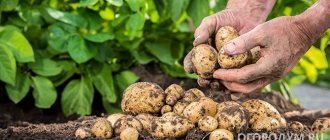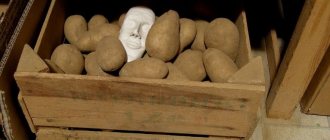Choosing suitable varieties
Mihkel Member FORUMHOUSE
For each potato variety there is a ripening period, according to which the varieties are divided into early, mid-ripening, late and others. There is no need to dig late-ripening varieties in August, but keep early ones until October. Early varieties are not very shelf-stable. They are mainly suitable for consumption and processing.
Potatoes of early varieties are intended for digging in the summer and eating in the fall. It will not be stored in the cellar, and, no matter how we conjure it, it will lie, at best, until December, and then it will grow sharply. Therefore, the participants of our portal do not plant a lot of early potatoes.
Yoursangel Member of FORUMHOUSE
I liked Zhukovsky Early - indeed, it is the earliest, large, healthy and tasty.
In addition to early varieties, there are varieties that require special storage conditions. Thus, the popular and tasty varieties Falensky, Berlichingham, Epron, Northern Rose love the cold and perfectly retain their qualities at a temperature of +1.5 - +2°C.
Skorospelka, Ogonyok, Agrotekhnicheskiy, Temp, Loshitsky, Foran are ideally stored at a temperature of +1.5 - +3°C.
Lorch, Table 19, Boiled, Start prefer heat +3 - +5°C.
Here are the varieties that, according to reviews from FORUMHOUSE participants, do not impose exorbitant demands on the temperature conditions of the potato storage: Lark, Vesna, Lorch, Atlas, Vesnyanka, Naiada (crumbly), Sorcerer, League, Naiad, Scarlet Sail, Luck and others.
Tips and tricks: how to store potatoes in the basement
Experienced gardeners share the secrets of long-term harvest storage:
- Early potato varieties germinate faster, so eat them first.
- Provide good ventilation.
- It is more practical to keep tubers in small containers of 10-15 kg. Place on pallets, covering the top from freezing.
- Before storing vegetables, disinfect them. Sort your crops monthly. Sick, rotten, damaged and green tubers are thrown away.
- Potatoes are stored better in boxes with onion peels.
What should be the temperature in the cellar?
Scientists have not yet resolved this issue; it is still being debated. A number of researchers insist that the lower the temperature, the better, and ideally, tubers should be stored at zero, at least at +1 -+2 °C. This slows down germination and does not allow harmful microorganisms to run rampant. It’s a paradox, but the results of numerous experiments show that at this ideal temperature, the shelf life of potatoes, on the contrary, decreases: at “near zero” the most aggressive microorganisms that attack the tubers survive in the cellar; In addition, at this temperature, the eyes die and the tissue of the tubers is damaged.
Therefore, for storing most varieties of potatoes, it is still recommended to maintain +2 - +4 °C.
This temperature is maintained until March, until the end of the natural dormancy period, after which it is recommended to lower it to +1°C so that the tubers do not germinate. Before planting, potatoes can be kept at this temperature without reducing their quality.
Lobelia Consultant FORUMHOUSE
This is a good temperature for storing potatoes. Humidity for storing potatoes should be within the normal range - 45-60%.
Sometimes potatoes germinate even with strict adherence to temperature conditions. The fact is that the duration of the dormant period of tubers is influenced by the conditions in which the potatoes grew.
The drier and hotter the summer, the less moisture the potato bushes received, the shorter the dormant period, the worse the tubers will be stored.
The keeping quality of potatoes is also affected by the mineral fertilizers that were used during its cultivation. Thus, excess nitrogen leads to a high content of sugars in tubers, as a result they are stored worse, especially if there are any diseases.
How to store potatoes so they don't sprout
Potatoes consume oxygen, evaporate moisture and consume starch. The warmer it is in the storage, the faster chemical processes occur in the tuber.
Starch is converted to sugar, which oxidizes, releasing carbon dioxide and water. As a result, the buds (in potatoes they are called “eyes”) swell and begin to grow.
Under prolonged exposure to heat, as well as natural or artificial light, the tubers will certainly germinate, so choose a dark place to store potatoes.
Neighborhood with other cultures
Potatoes do not like proximity to other vegetable and fruit crops and prefer to “winter” separately . The only exceptions are beets and radishes.
Beets perfectly absorb excess moisture, which helps them retain their taste longer. And the potatoes thereby acquire a protector from rotting and sprouting.
Some gardeners advise putting several apples in each box of potato tubers; it is believed that they also know how to deal with humidity.
Advice! Lavender, rosemary and sage will help prevent early active eye formation. Place these herbs on potato beds.
Incorrect temperature and humidity
The best “friends” of potato sprouts are temperatures above +7°C and humidity above 50%. Such conditions will lead not only to the formation of sprouts, but also to drying out, and then to rotting and death of the entire crop.
What to do to prevent potatoes from sprouting in the cellar
There are four simple ways to protect the “second bread” from early sprouting:
- Store the vegetable in a dark, dry place.
- Maintain temperature conditions from +2 to +6°C and humidity no more than 50%.
- Do not stack together with other garden crops, except radishes and beets.
- Use mint essential oils to slow down the natural processes occurring in potatoes. To do this, saturate a small piece of gauze with oil and place it where the potatoes are stored. Renew the gauze 1-2 times a month as needed.
We monitor the quality of tubers
Potato agronomists believe that the quality of tubers has no less influence on the preservation of tubers than the variety.
Tubers to be stored must be:
- undamaged;
- clean;
- unsprouted;
- smooth, approximately identical in shape;
- ripe, with thick skin.
Mihkel
The easiest way to tell if a potato is ripe is to rub the skin with your fingertip. If the skin peels off (flakes), the potato is not yet ripe. If it stays tight, that's it.
You can help potatoes grow skin if you mow the tops 5-7 days before digging. The tops are mowed, leaving stumps 15 cm high.
Under no circumstances should tubers affected by phytophotora, as well as any type of rot, be sent for storage. Be careful not to put a frozen tuber in the basement along with the rest of the potatoes - it reduces the keeping quality of the entire crop.
Not only the type of potatoes is important, but also the smell: if pesticides were used during cultivation, and the tubers smell somehow strange, they cannot be stored.
Before storage, the tubers must develop a strong, durable skin. The fact is that microorganisms will not penetrate tubers with intact, strong, undamaged tissues. All micro-wounds of the tuber heal if the dug potatoes are kept for two to three weeks at +12 - +18°C and air humidity 90 - 95%. This period is called the healing period.
What containers should you store potatoes in?
To ensure that the potatoes do not germinate ahead of time and overwinter well in the chosen room, it is important to observe the temperature regime, strictly ensure that the vegetable is not exposed to light and there is air exchange around the clock.
Taking these rules into account, select a suitable container:
- Wooden boxes. Loose boards and the opening top of such a container promote natural air exchange. The boxes are mobile, they are convenient to move, lift and carry. The optimal distance between them is 15 cm, the gap to the wall is at least 30 cm, to the ceiling is at least 50 cm. Do not place the container on a concrete floor, place boards, pour a thick layer of sawdust or a wide sheet of cardboard folded several times.
- Mesh or linen bags . They allow you to monitor the condition of tubers, sort out damaged, frostbitten and rotting ones. Such containers require additional light insulation. Be sure to cover them with thick cloth and then periodically open them for ventilation.
- Wicker baskets and plastic containers with ventilation holes.
Package method: will the potatoes be stored?
Scientists of the All-Russian Research Institute of Potato Farming named after. A.G. Lorch determines how suitable potatoes are for long-term storage using the so-called bag method. The method is simple and easy to apply in home and country settings. To do this, a couple of weeks before harvesting potatoes, you need to dig up several bushes, select healthy-looking tubers, fill them with a large plastic bag and leave them for two weeks at a temperature of +15 - +20°C. The bag creates an ideal microclimate for microorganisms, and if the tubers have even the slightest infection, then phytophotora spots, traces of wet rot and other diseases will appear on them. The more tubers are affected, the worse the crop will be stored. If all the tubers are clean, then your potatoes are healthy.
Preparing the storage area
Most often, basements and cellars are used to store this crop. As a last resort, an underground or pantry is suitable (and only assertive people, with great desire and opportunity, allocate a place for potatoes on the balcony or at home). Vegetable storage must be properly prepared for the winter. First of all, it is thoroughly cleaned. To disinfect walls and ceilings, we use a solution of lime or an aqueous mixture of lime and copper sulfate. These substances perfectly protect against the development of pathogenic microorganisms. In some cases, gardeners and summer residents fumigate their premises with sulfur, but in recent years this method of disinfecting storage facilities has been used less and less, since it requires long-term ventilation of the premises.
We treat shelves, racks, drawers, panels, stairs, hoods, vents 2-3 times with a dark pink solution of potassium permanganate. After this, ventilate the room well so that all surfaces are completely dry. The storage must be well thermally and waterproofed.
Folk tricks
Experienced summer residents often use folk methods of preserving potatoes. This is a well-known folk method in which the leaves and grass of plants containing phytoncides are placed in a room with tubers. They suppress the growth and development of pathogenic microorganisms. These include fern, rowan, tansy, basil, peppermint, horseradish, and wormwood. You can also place branches of coniferous trees in the storage area with vegetables. Sprinkling the tubers with dry onion peels also prevents the development of pathogenic fungi and bacteria.
Methods for storing potatoes
There are several ways to store potatoes. Their choice depends on the number of tubers and the type of storage. The most popular types:
In bulk
In which a small amount of tubers is stored. In large heaps there is a danger of pathogenic microorganisms infecting a significant number of tubers.
In wooden and plastic boxes
With slots for ventilation. Coniferous wood species, which have phytoncidal properties, are most suitable for their production.
In containers
A method that is the most optimal storage method for summer residents. A standard container with holes for ventilation is designed for 500 kg of tubers. They can be placed in 2-3 tiers.
In nets or bags
When potatoes prepared for storage are poured into nets or natural bags in small portions.
In trenches (pits)
Not every summer resident has a plot with a cellar or basement. In this case, the old method can be used to store potatoes, in which vegetables are perfectly preserved right outside until spring. To do this, we place the prepared tubers in trenches or holes, the depth of which should be at least a meter.
Each layer of tubers must be covered with a layer of soil (3-4 cm). Then these trenches and holes are covered with earth and covered with straw or other insulating materials. The thickness of the shelter depends on the ambient temperature. In severe frosts, it can reach 1 m. The main disadvantage of this method is that in order to use a certain number of tubers, you have to constantly disassemble and rebuild the entire structure.
Storing potatoes at home
In a city apartment, you can store potatoes on a balcony or loggia. For containers, use sealed boxes with a double bottom and walls. To protect against freezing on a cold balcony, insulate the inside of the container with polystyrene foam. Cover the top of the box with a lid or a dark, warm cloth to protect the tubers from light.
To avoid rotting and sprouting of produce, place rowan or mint . Such plants not only help maintain optimal humidity, but also destroy pathogenic microorganisms due to the released phytoncides.
The following will also help against rotting tubers: onion peel , dried herb , wormwood , fern , elderberry leaves .
You can transfer the tubers with pine paws or store the potatoes in boxes made from fresh spruce or pine boards.
It is very useful to keep potatoes and ginger root (both keep better).
If you want to store a large amount of crops on the balcony in winter, prepare a special chest where the optimum temperature and humidity will be maintained. How to do it correctly, watch the video:
You should store potatoes at home in the summer in the pantry or under the kitchen sink. To do this, place the vegetables in a wicker basket, plastic box or perforated bucket. The shelf life of potatoes in such conditions is 14 days.
There is an opinion that you should not use plastic bags or polypropylene bags for storing potatoes (they do not allow air to pass through, which leads to rapid rotting and spoilage of the product). But if the potatoes are prepared for storage according to all the rules, then the average number of tubers (up to 20 kg) can be kept for 3-4 weeks at room temperature in a plastic bag . Conditions: the bag must be thick, dark and very well tied (for example, garbage bags). The main thing is not to open the package “in between” and not to disturb it at all.
In a city apartment, you can store potatoes under the sink in a wicker basket, wooden or plastic box. You can also organize storage on a balcony, loggia or in the entrance corridor
Storing potatoes in the refrigerator
Many housewives are concerned about the question: is it possible to store potatoes in the refrigerator? The refrigerator maintains optimal temperature and humidity, making it suitable for storing potatoes. However, remember the significant drawback of this method - limited space does not allow you to save much harvest.
To store potatoes in the refrigerator, place the potatoes in a paper bag and place it in the crisper drawer . In such conditions it can persist for up to several months. The refrigerator is ideal for storing finished potatoes - boiled, baked in jackets or stewed. This allows you to make preparations for the morning or for several days.
Sometimes housewives need to preserve peeled potatoes. To do this, place the tubers in a container and fill with cool water. You can store peeled potatoes at room temperature for 2-4 hours, and in the refrigerator for 2 days.
How to store potatoes in the freezer
Potatoes are perhaps the only vegetable that is not recommended to be frozen raw . Under the influence of low temperatures, starch turns into sugar, which affects the taste of the product.
However, you can store a small amount of blanched vegetable in the freezer. To do this, you need to prepare it correctly:
- Wash and peel the tubers well.
- Cut the potatoes into strips 1-1.5 cm thick.
- Place the raw materials in a colander and rinse with water to remove starch.
- Place the potatoes in boiling water for 3 minutes and then in ice water.
- Dry the workpiece with a paper towel and place portions in freezer bags.
- Place the potatoes in the freezer. In this form, the vegetable can be stored for as long as possible.
The main rule of freezing is to create portioned preparations, since potatoes cannot be re-frozen.
Before freezing, be sure to wash, peel and blanch the potatoes. Do not put raw potatoes in the freezer - they will lose their basic taste.
You can also store already cooked potatoes in the freezer: boiled mashed potatoes, fried baked slices. Prepare the potatoes using your favorite method, cool and place in plastic containers or freezer bags. Put the products in the freezer, and you will always have a ready-made preparation for lunch or dinner at hand.











